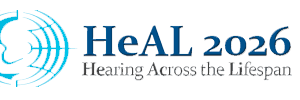Positive Effects of Newborn Hearing Screening
The sense of hearing is the foundation for communication and promotes social interaction. Hearing is the key to learning spoken language and is important for the cognitive development of children. Hearing loss is a barrier to education and socialization especially when it goes undetected and untreated. A baby born with hearing loss that is not detected and treated early will not achieve the typical developmental milestones expected in the first months and years of their life.

0 - 3 Months
Your voice can soothe and quiet fussy babies and they react or waken to loud sounds. During feeding, babies will change their sucking pattern in response to sound.
Babies with unidentified hearing loss may still react to loud sounds, depending on the level of hearing loss. A baby with significant hearing loss will probably not be soothed by voice or react to quieter sounds unless there are accompanying visual or tactile cues also provided. Without newborn hearing screening, babies with hearing loss are typically not identified during this time!
3 - 6 Months
During this period, babies react to changes in the tone of your voice and show interest in toys with sounds or music. They babble using different sounds and you can notice vocal changes.
Babies with unidentified hearing loss will not display these behaviors or may only do so when the voice, music or sounds are very loud or if there is some accompanying visual aspect to the experience. With newborn hearing screening, the goal is that a baby born with hearing loss has been detected, diagnosed and intervention has been initiated by 6 months of age.


7 - 12 Months
Now, babies start to look in the direction of a sound or voice and actively listen & imitate speech sounds. By 12 months, they may can use 1-2 words.
7-12 month old babies with unidentified hearing loss will not pay attention to or track the direction of a sound unless there are also visual cues provided at the same time. They will not show understanding of words or progress in imitation of speech sounds. At one year, they will not have any vocabulary words. Close family members may begin to notice differences in the baby’s development compared to other babies of this age.
1 - 2 Years
When turning one, babies follow simple commands, listen to stories & songs or point to pictures when named. Their single-word vocabulary grows and they start to put two words together.
During this period, babies with unidentified hearing loss will significantly fall behind in achieving these milestones. Without newborn hearing screening history shows that even at this age toddlers with hearing loss are not identified and do not receive intervention.


2 - 3 Years
At 2 to 3 years, they mainly use two or three word phrases and family members can understand their speech. They will also ask for objects by name.
Without newborn hearing screening, this is the average age range at which hearing loss is finally identified based on parents’ concerns about the child’s development. By this time a critical period for brain development for language and speech learning has passed – making it more challenging for a child to develop language and speech skills.
3 - 4 Years
By now, children listen to the TV at the same volume as their family members and respond when called from another room. They answer question and talk about experiences using 3-4 word sentences.
During this period, children with unidentified hearing loss will continue to significantly fall behind in achieving these milestones. Without newborn hearing screening, some children are not identified until this age. The later a child’s hearing loss is identified and treated, the more difficult it will be for her/him to succeed in an educational setting with their normal-hearing peers.

With newborn hearing screening & providing intervention very early in life, children born with hearing loss can develop speech and language skills that are appropriate for their age and can start their formal education in the same classroom as their normal hearing peers.
Do you want more information? Download the whitepaper from our friends at Oticon Foundation here:
MAICO Solutions for Newborn Hearing Screening

For OAE screening and testing
ERO•SCAN
- Screening and diagnostic tests with TEOAE and /or DPOAE
- Automated tests with Pass/ Refer and graphical result display
- Color OLED-display and button navigation
- 2 DP and 2 TE screening protocols
- 5 DP and 3 TE diagnostic protocols, customizable protocols included
- Wireless PC connection and optional printer

Screening without disposables
MB II BERAphone®
- Automated ABR screening for fast results
- Integrated electrodes to save costs for disposables
- Comfortable hearing screening for the baby without adhesive disposables
- With automatic impedance check to indicate test conditions
- USB connection for data transfer and recharging
- Export patient data for tracking

The name says it all
easyScreen
- Now available with unique BERAphone®
- Fast and easy ABR + OAE screening
- Results within seconds due to powerful ABR detection algorithm
- On-screen guidance for ideal test conditions and accurate results
- Large LED-color screen for comfortable navigation
- HearSIM™ patient database and device manager

Did You Know?
Newborn babies cry with regional „accents“ copied from their mothers
(Prof. Dr. Kathleen Wermke)

